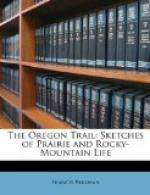Advancing with our new companion, we found more of his people seated in a circle on the top of a hill; while a rude procession came straggling down the neighboring hollow, men, women, and children, with horses dragging the lodge-poles behind them. All that morning, as we moved forward, tall savages were stalking silently about us. At noon we reached Horse Creek; and as we waded through the shallow water, we saw a wild and striking scene. The main body of the Indians had arrived before us. On the farther bank stood a large and strong man, nearly naked, holding a white horse by a long cord, and eyeing us as we approached. This was the chief, whom Henry called “Old Smoke.” Just behind him his youngest and favorite squaw sat astride of a fine mule; it was covered with caparisons of whitened skins, garnished with blue and white beads, and fringed with little ornaments of metal that tinkled with every movement of the animal. The girl had a light clear complexion, enlivened by a spot of vermilion on each cheek; she smiled, not to say grinned, upon us, showing two gleaming rows of white teeth. In her hand, she carried the tall lance of her unchivalrous lord, fluttering with feathers; his round white shield hung at the side of her mule; and his pipe was slung at her back. Her dress was a tunic of deerskin, made beautifully white by means of a species of clay found on the prairie, and ornamented with beads, arrayed in figures more gay than tasteful, and with long fringes at all the seams. Not far from the chief stood a group of stately figures, their white buffalo robes thrown over their shoulders, gazing coldly upon us;




